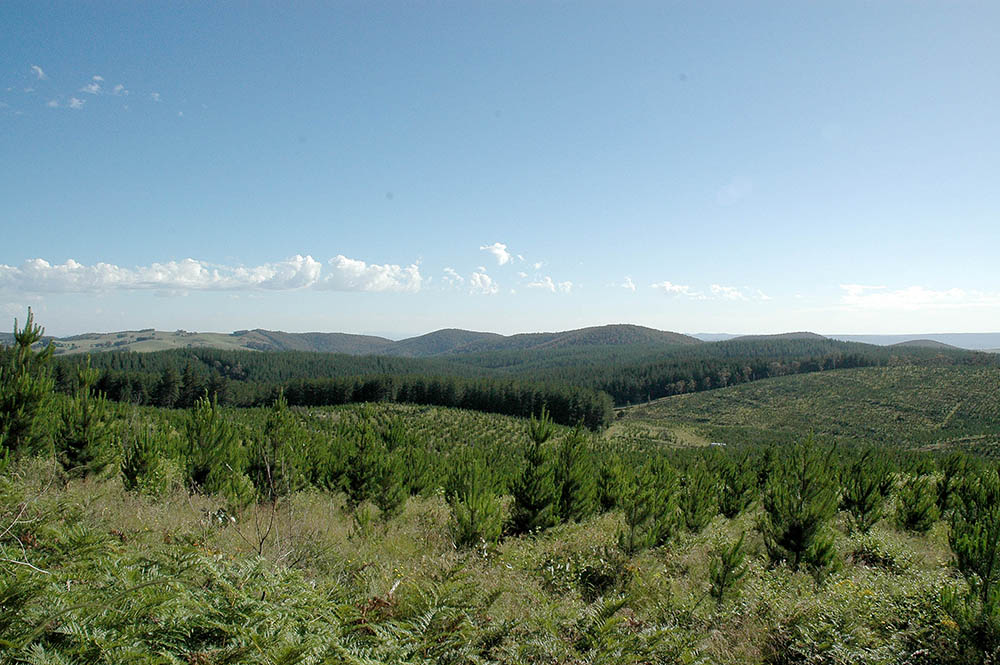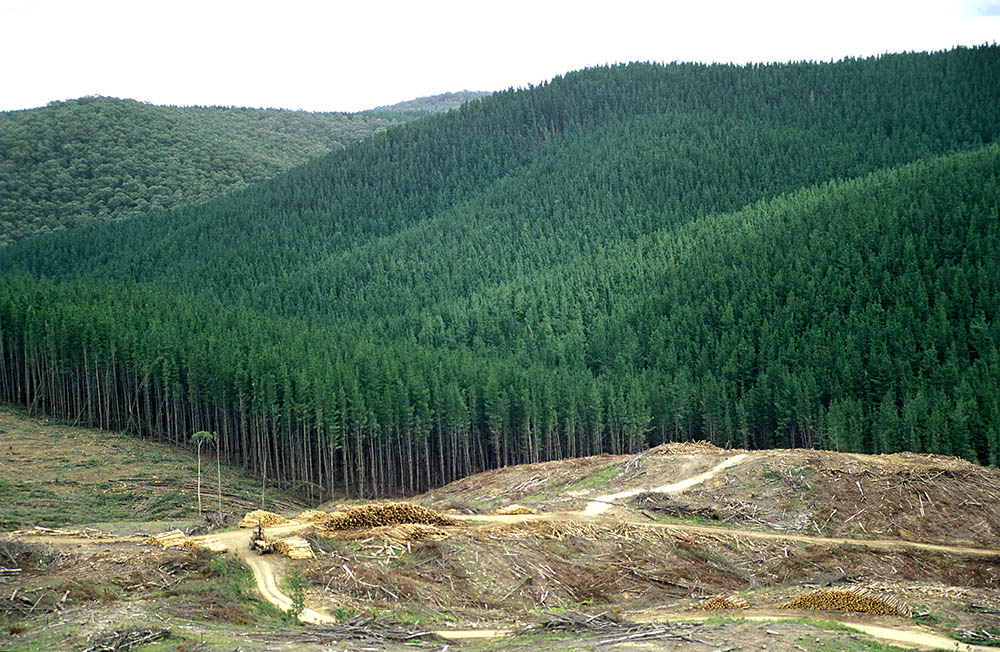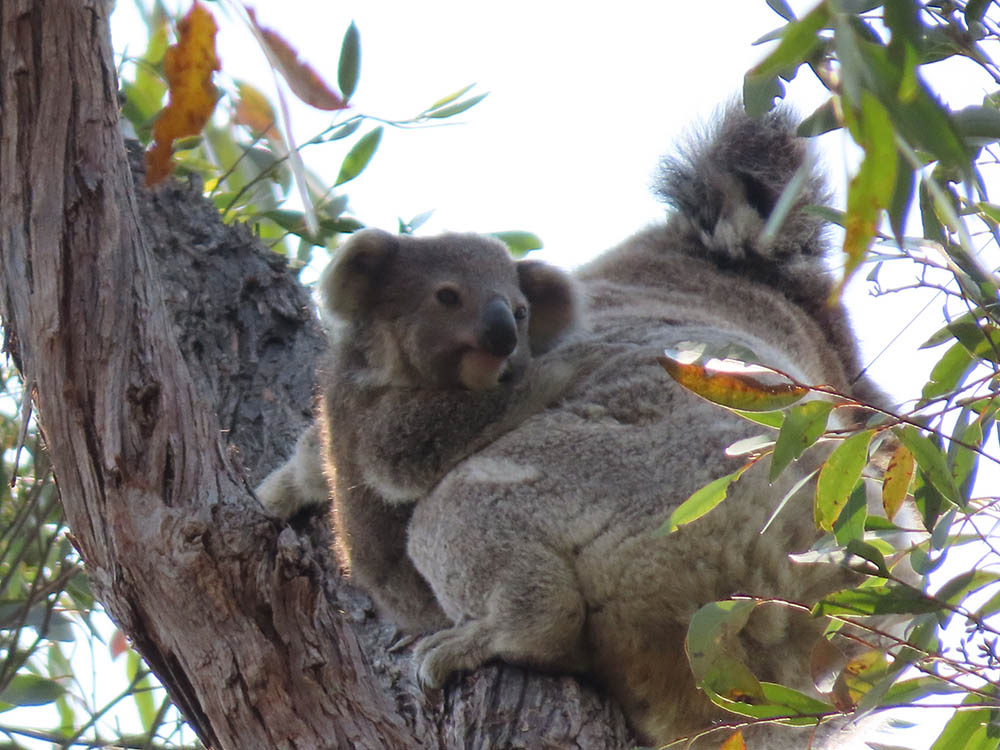At the date of publication, detailed industry information for 2021-22 is not available, consequently the following production, plantation and price commentary analyses 2020-21 industry data.
- GVP $440 million est. Down 3% year-on-year.
- The higher rate of softwood supply was driven by ongoing bushfire salvage operations.
- NSW had 348 thousand hectares of commercial plantations in 2020-21, second only to Victoria’s 383 thousand hectares.
Production
Softwoods generally come from commercial plantations. Softwood production in 2020-21 increased by a modest 2% to 5.7 million cubic metres. 34 This was 25% higher than the normal rate of production and the largest volume ever harvested in a single year. 33 The higher rate of softwood supply was driven by the fire salvage operations, intensified by the tight salvage timeframe. Burnt timber, damaged and dying trees deteriorate rapidly and become vulnerable to pests and disease. Two-thirds of the 5.7 million cubic meters harvested was fire-salvaged wood. 33 Softwood sawlog production was steady and accounted for the majority of softwood production at 3.1 million cubic metres, whilst paper pulplog production increased slightly by 1% and accounted for 2.4 million cubic meters. 34 Other minor log products were up 68% year-on-year to 238 thousand cubic metres.
Hardwood production was down significantly to 698 thousand cubic metres, a 22% decline over the previous year. 34 This decline was particularly in native forests due to heightened environmental protection measure and weather damaged supply (in response to bushfire and extreme wet weather and flooding). Sawlog production from hardwood plantations increased 12% over 2020-21 34 to which, to a small degree, offset the decline in native sawlog production. Hardwood production mainly consisted of sawlogs (446 thousand cubic metres harvested) and woodchip pulplogs (210 thousand cubic metres harvested). 34

Plantations
Whilst the volume of softwood harvested in NSW has increased by about 94% over the past 20 years, the amount of land plantations has been relatively stable since 2014. No new softwood plantations have been established since 2015-16. 34 Nationally, a similar trend has been observed in terms of the area under plantation which has been largely stagnant since 2014 however, since 2015, a total of 9,000ha of new softwood plantation have been established in Western and South Australia. 34
Hardwoods largely come from native forests with native plantations only contributing approximately 43% of total NSW production. Supply is projected to fall further when Queensland and Western Australia end native logging in 2024, and Victoria in 2030.
Price
Log price indexes by log type 34
- Hardwood Native saw and veneer logs
- Hardwood Native pulplogs
- Hardwood Plantation saw and veneer logs
- Hardwood Plantation pulplogs
- Softwood Native saw and veneer logs
- Softwood Native pulplogs
- Softwood Plantation saw and veneer logs
- Softwood Plantation pulplogs
Trade and Macroeconomic Conditions
NSW wood product exports in 2021-22 were valued at $58.2 million, down 58% year-on-year. 35 In value terms, up until the loss of the Chinese export market, approximately 90% of NSW wood product exports traveled to just two main markets, namely China and South Korea. 35 In 2021-22, whilst exports diversified slightly, exports were largely limited to five key markets namely South Korea, India, Vietnam and Taiwan. 35
While Australia and NSW are net exporters of unprocessed wood (primarily unprocessed or minimally processed products like wood in the rough or sawnwood), they are net importers of processed wood products. Due to the reduction in domestic supply, Australian builders have become more reliant on imported timber. The Australian Forest Products Association (AFPA) forecasts that Australia’s reliance on imported timber will double by 2050 and that there will be an implied gap between demand and local production of 2.6 million cubic meters per annum. 31
Employment and Value Added
Industry value added for 2021-21 (measured as production output less intermediate inputs) remained steady year-on-year and was estimated at $3 billion. Industry value added for Australia was estimated at $8.7 billion. 185
Outlook
New trade sanctions in response to the ongoing Russia and Ukraine conflict may have the potential to further impact imported timber supplies. Whilst Russia is not a major supplier of timber products to Australia (in terms of total value), they are one of the largest suppliers of engineered wood products which includes laminated veneer products and plywood), key structural elements used in residential and commercial buildings and timber flooring systems. The invasion of Ukraine has led international forestry groups to deem timber from Russia and Belarus “conflict timber” and as a result, Australia will place tariffs of 35% on timber from the two nations after October 2022. No further updates on this situation were available at the time of writing (September 2022).

Stronger Primary Industries Strategy
Response of Koalas to the black summer fires and timber harvesting
With koalas just listed as Endangered, it's more important than ever to scientifically assess the key threats to their populations. DPI Forestry's ecology team have recently conducted parallel research projects investigating the impact of forest disturbances – bushfires and timber harvesting – on koalas as part of efforts to better understand koala habitat threats and risks.
Strategic Outcome


In the areas greatly affected by high severity fire, koalas were found to have commenced recolonisation within the following year.
Dr Brad Law said the research assessed the extent of impact of hot severe bushfires on koala populations, and how the impact varied according to fire severity and patchiness. Signs of recovery of koala numbers within 12 months were encouraging. The DPI Forest ecology team is continuing to monitor koala recovery.
Response to harvesting In a parallel three-year study, DPI Forestry scientists recently assessed the response of koala density to timber harvesting across 3,600 hectares of forest. The team used acoustic arrays to record bellowing koalas combined with advanced modelling techniques to provide an estimate of koala density in 400 ha patches of forest. The acoustic arrays were also supplemented with koala detection dogs to confirm sex ratio from fresh scat. The experiment assessed change in koala density after selective harvesting with regulations in place to protect environmental values, and additional sites that were heavily harvested 5-10 years previously, now dominated by young regeneration. Paired sites in nearby National Parks served as controls. The study concluded that native forestry regulations, which set aside a network of environmental protections, provided sufficient habitat for koalas to maintain their density, both immediately after selective harvesting and 5-10 years after heavy harvesting. Koalas were recorded at almost every song meter (225 in total) before and after harvesting, indicating koalas were widespread across all arrays. Average density was estimated to be higher than expected for forests in NSW. The study found no significant effect of selective harvesting on density and little change was evident between years or between state forest and the control sites in national parks. Also, density 5-10 years after previous heavy harvesting was equivalent to control sites, with one previously harvested array supporting the second highest density in the study. In north-east NSW, regulatory settings introduced in 2018 result in 57% of the state forest landscape being excluded from harvesting and this is key to supporting koala populations, especially during the initial stages after a forest disturbance. The outcomes for koala density are also consistent with the findings of GPS tracking of individual koala behaviour through this same period. GPS tracking demonstrated that koalas (including breeding females) routinely used disturbed areas, areas of regeneration and older forest in exclusion zones.
Publication - Regulated timber harvesting does not reduce koala density in north-east forests in New South Wales


